The Association of British Counties (ABC) promotes the importance of the historic counties of the UK to our history, heritage and culture. The biggest challenge facing the identities of the historic counties in England is the continued confusion of the historic counties with local government areas. Moves towards unitary local government in England provide the perfect opportunity to clear up the longstanding confusion between the historic counties and local government once and for all.
Local government structure in England is defined by the Local Government Act 1972 with its stipulation that “for the administration of local government” England “shall be divided into local government areas to be known as counties and in those counties there shall be local government areas to be known as districts”. The unqualified use of the word ‘county’ by the 1972 Act and the ‘county councils’ it created (many which bore little resemblance to any historic county) had a negative impact on public understanding and appreciation of the historic counties – despite the Government’s repeated assurances that these changes were solely for administrative purposes and did not affect the historic counties.
Since the 1990s, many areas of unitary local government have been created by the device of creating a local government ‘county’ with a coterminous ‘district’ and then ascribing all local government functions to a single district council. Such unitary authorities have generally been given the style ‘council’ rather than ‘county council’. Many make entirely appropriate (qualified) use of an historic county name, e.g. ‘Central Bedfordshire Council’, ‘Cheshire East Council’, ‘North East Lincolnshire Council’.
However, the word ‘county’ is still used to describe many local authority areas and the phrase ‘county council’ is still used to describe many local authorities. Most of these continue to use the unqualified name of an historic county despite having an area very different to that historic county. ABC does not have a view on the structure of local government, but we do recommend that:
• All new unitary authorities should be given the title ‘council’ rather than ‘county council’;
• All new unitary local government areas should be referred to as ‘local authority areas’ or ‘council areas’ (as are those in Scotland) rather than as ‘counties’. If all the remaining two-tier areas are to be replaced by unitary local government then the term ‘county’ can be removed from local government legislation and parlance altogether.
• No new unitary authority or combined authority should be given the unqualified name of any historic county unless its area closely matches that historic county.
New unitary authorities could make qualified use of historic county names where this is appropriate, e.g. as do the new ‘North Northamptonshire Council’ and ‘West Northamptonshire Council’.
Here we consider the local government situation in five areas likely to be among the first to be reorganised and discuss the need for a more sensitive naming of the successor authorities.
In June 2021, Robert Jenrick, Secretary of State for Housing, Communities and Local Government, announced that Somerset County Council and the district councils in its area would be replaced from April 2023 by a single new unitary authority, to be based on the area of the current Somerset County Council.
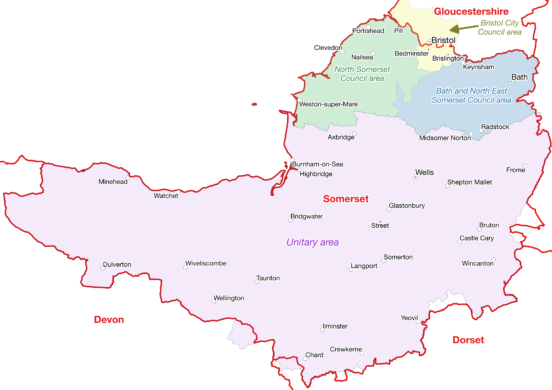
The new unitary area covers a large part of the historic county of Somerset. But it does not cover a large, highly populated area in the north of the historic county. Much of this remaining area is covered by the existing unitary authorities of ‘North Somerset Council’ and ‘Bath and North-East Somerset Council’. A small area of the historic county of Somerset lies in the south of Bristol City Council area. Only 53% of the population of the historic county of Somerset lies in the new unitary authority area.
It would be wholly inappropriate for the new authority to make unqualified use of the historic county name, i.e. as “Somerset Council”. A more appropriate name would be “South and West Somerset Council’.
In June 2021, the Secretary of State announced that Cumbria County Council and the district councils in its area would be replaced from April 2023 by two new unitary authorities, one to be based on the combined area of the current Allerdale, Carlisle and Copeland districts and the other on the combined area of the current Barrow, Eden and South Lakeland districts.

The current Cumbria County Council area covers the historic counties of Cumberland and Westmorland, along with the Lancashire North of the Sands area of the historic county of Lancaster and the Sedbergh area of Yorkshire. The name ‘Cumbria’ is not directly borrowed from an historic county though it is essentially a synonym for Cumberland. Cumbria County Council has consistently fostered the identity of Cumbria as a county, strongly to the detriment of the identities of the historic counties in its area, which it has made no effort to acknowledge or promote. Given this, it would be highly desirable if the new authorities were not given names which perpetuate ‘Cumbria’.
The western of the two new authorities lies entirely within Cumberland and it would seem entirely appropriate if this area used ‘Cumberland’ within its name. However, only 77% of Cumberland lies in this new authority’s area, although it does contain 90% of the population of the historic county. Simply calling the new authority ‘Cumberland Council’ would not be appropriate. However, ‘West Cumberland Council’ or a name along these lines would be entirely appropriate.
The eastern of the two new authorities covers part of four historic counties. This clearly makes using county names within the authority name challenging and a county-neutral name such as ‘Lakes and Dales Council’ would certainly be a sensible option.
The new authority area does, however, cover all of the historic county of Westmorland. In fact, 54% of the new authority’s area and 39% of its population lies in Westmorland. Given this, the inclusion of ‘Westmorland’ as a part of the name of this authority seems appropriate.
The new authority also covers all of the Lancashire North of the Sands (Furness) area of Lancashire. Although only 16% of the new authority’s area lies in Lancashire, this area does include 45% of the new authority’s population. A name such as ‘Westmorland and Furness Council’ has the advantage that it describes the greater part of the council area and, importantly, is clearly not pretending to be a county or to deny the historic county identity of places within it.
However, 28% of the new authority’s area and 14% of its population lies in Cumberland. In addition 6% of the new authority’s area and 2% of its population lies in the Sedbergh area of Yorkshire. Finding a name which reflects all of these is challenging. Something like ‘Westmorland and South Lakeland Council’ may fit the bill.
In June 2021, the Secretary of State also announced that the current North Yorkshire County Council area is to be used as the basis for a new unitary authority from April 2023.
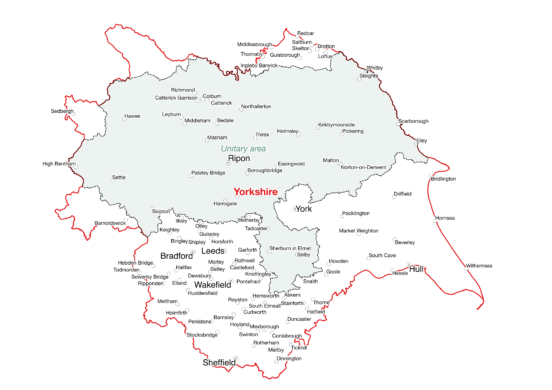
The name ‘North Yorkshire Council’ would be perfectly appropriate since this authority will cover an area mostly in the north of the historic county of York. We should be wary of attempts to misuse the name of the North Riding in this process, as the name of the East Riding has been misused for a unitary authority area.
The current Lancashire County Council area only covers about 24% of the population of the historic county of Lancaster. It does not cover a huge, heavily populated area in the south of the historic county. Nor does it include the Lancashire North of the Sands area. Nor does it include the unitary authorities of Blackpool and Blackburn with Darwen. It does, however, include a huge area in the Forest of Bowland, part of the historic county of York, including the towns of Earby and Barnoldswick.
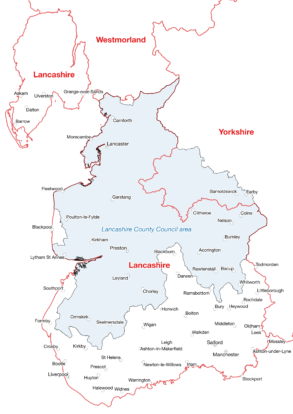
If a new unitary authority were to be based on the current Lancashire County Council area, or some combination of it with the Blackpool and Blackburn with Darwen unitary authorities, then the new unitary authority should not make unqualified use of the name “Lancashire”, i.e. as “Lancashire Council”. If the name “Lancashire” is to be used then it should be with appropriate qualification, in a name such as “Central Lancashire and Bowland Council”.
Alternative models which would see the current Lancashire County Council area, possibly along with the Blackpool and Blackburn with Darwen unitary authorities, formed into two or three new unitary authorities should enable appropriate, qualified use of the name “Lancashire” within the new authority names, although ABC certainly does not see the use of the name “Lancashire” as an essential part of a local authority based in Lancashire.
If a combined authority were to be formed from a combination of the newly created unitary authorities, essentially with the same or very similar area to the current Lancashire County Council area, then it is essential that this combined authority does not use the unqualified name “Lancashire”, for the same reason this name in wholly inappropriate for the current Lancashire County Council area.
The Surrey County Council area covers much of the west and south of the historic county of Surrey. However, it does not cover the highly populated part of the historic county of Surrey which lies in the metropolitan area. It also covers the Spelthorne area of the historic county of Middlesex, including the Middlesex towns of Ashford and Staines.
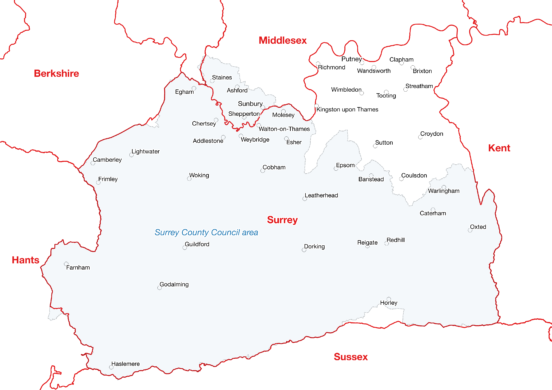
The Surrey County Council area only includes 37% of the population of the historic county of Surrey. 8% of the population of the Surrey County Council area lives in the historic county of Middlesex.
If the current Surrey County Council area were to be used as the basis of a new unitary authority then it should not make unqualified use of the historic county name, i.e. as “Surrey Council”.
Given the population size of the Surrey County Council area then it seems probable that the area will form two or more new unitary authorities. Finding appropriate names which make qualified use of the name “Surrey” would likely be straightforward in these scenarios. However, any new unitary authority which includes the Spelthorne area of Middlesex should be given a name which reflects this fact and not be presented as lying entirely within Surrey.
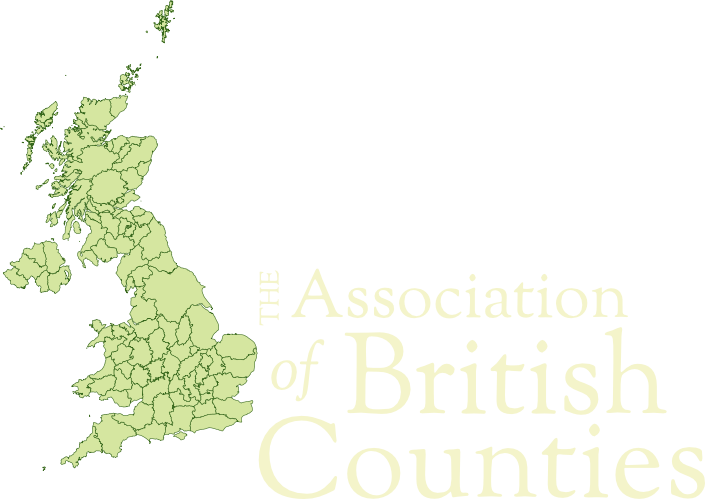
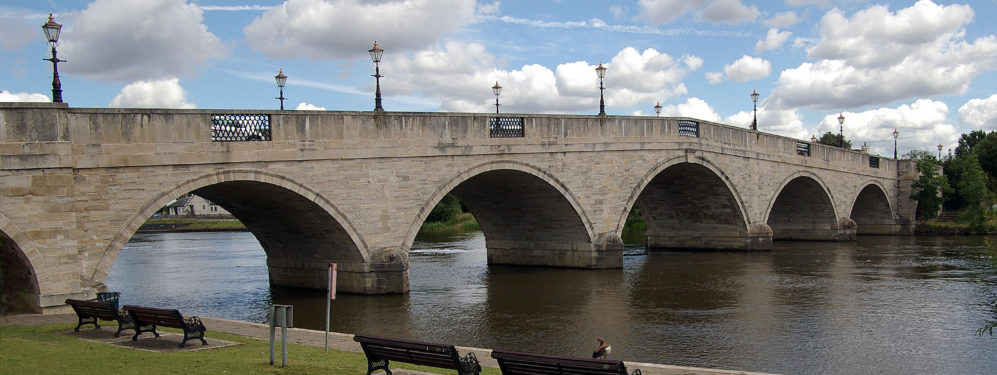
19 thoughts on “Local government naming that respects the historic counties”
We still love the ‘Riding’ names in Yorkshire. I would still prefer West Yorkshire to be called West Riding of Yorkshire, even though it’s ‘lost’ a lot of its territory to Great Manchester etc.
We love the Ridings too. We want to see them properly marked on road signs and maps and used by the media etc. But we don’t want to see a Riding name used for a local government area unless that local government area closely matches the Riding’s area. The ‘West Yorkshire’ area isn’t much like the real West Riding and to use ‘West Riding’ for its name would be to undermine the real West Riding, far worse than if the West Riding name is not used in local government at all. It is very hard to see any new unitary authority area being created from the current ‘North Yorkshire’ area which is anything like the North Riding. We were just making the point that the name ‘North Riding’ should not be then be applied to an area unless it really does closely match the North Riding.
The Historic Ridings of Yorkshire are over one thousand years old. Anything other than those so named are a travesty of the original. The so-called East Riding cannot be so without the North & West. As for South Yorkshire well that is a step too far. I was born in the West Riding and proud of it too. We must fight to preserve our historic boundaries for future generations.
Having created ‘Greater Manchester’ and ‘Merseyside’ these definitions appear to me to be currently redundant as authorities. Were it not for the police forces bearing the name it would surely be more acceptable to Lancastrians to include the county name (as in Yorkshire and some southern counties), and adopting North, East, West and South Lancashire rather than significantly reducing the county to almost nothing. There has always been an uncomfortable feeling about Lancashire Cricket Club representing these former areas of the county.
I wouldn’t mind seeing Merseyside Police become “South West Lancashire and North West Cheshire Police” (or “South West Lancashire and Wirral Police”) and Greater Manchester Police become “South East Lancashire and North East Cheshire Police” despite the fact that “Greater Manchester” includes Saddleworth (Yorkshire) and excludes Tintwistle (Cheshire, but administered by Derbyshire County Council), but the likelihood of any authority in Britain being given such a long designation must be small.
‘Cleveland’ continues to be a problem. Even though the Royal Mail has altered areas both north of, and south of the River Tees, the name ‘Cleveland’ is still being used to the point of obsession. The vast majority of businesses (and people) write ‘Cleveland’ on their mail and websites be they in Hartlepool/Middlesbrough/Stockton/ Redcar/Guisborough/Yarm/Saltburn and so on.
This false monstrosity will not go away, As we all know the ancient Kingdom of Cleveland was a Wapentake entirely within Yorkshire, yet was stolen in 1974 by Whitehall bureaucrats as a name for ‘Area No. 4’ (which was going to be an extended ‘Teesside’ itself not a County but wildly celebrated in 1968 in Middlesbrough as ‘The Birth of Teesside’ even with street parties held in Middlesbrough, the exact opposite of how Humberside was viewed in Hull). It is as though Middlesbrough has always wanted to ‘escape’ Yorkshire for whatever reason, so ‘Cleveland’ was taken in with gusto. It will not go away. It is with Cleveland exactly the same as the ‘Cumbria’ situation.
It is time that ‘Cleveland’ and ‘Cumbria’ were expunged from the English Language but it will take political will which is unlikely.
What I’d like to happen with “Cleveland” is not for the word to be expunged from the English language, but for folks to start using it properly again – i.e., to go back to using it to refer to the ancient region that encompasses settlements as far apart as Staithes, Moorsholm and Great Ayton (not to mention the places known in full as Skelton-in-Cleveland and Carlton in Cleveland) but doesn’t extend north of the River Tees.
Alas, I fear you’re right about the fake “Cleveland” being too burned into local people’s psyches for there to be much chance of it ever going away – especially all the while there is a police force called “Cleveland” whose area is coterminous with that of the former county council. Likewise with “Merseyside” (albeit Southport appears to be clinging to a Lancashire identity) and, as you’ve noted, “Cumbria” (though, as in Southport, a sense of belonging to Lancashire does seem to have persisted in Furness to a significant degree).
In my first paragraph I omitted that Royal Mail finally indeed refers to areas south of the Tees as NORTH YORKSHIRE, and north of the Tess to COUNTY DURHAM… but people and businesses do NOT accept it and continue with the fake ‘Cleveland’ even though it only lasted 1974-1996 and has now gone 25 years back!
It is unbelievable that both young and old still cling to ‘Cleveland’ and completely detest both Yorkshire and County Durham.
Yes! Get rid of “Cumbria” – it’s too true that “Cumbria” has completely removed Cumberland from use in addresses and people’s conceptions of where they are living. Cumberland and Westmorland are hardly ever used in business official addresses, or in lists of counties in drop-down menus on the internet, or even official post office addresses. Politicians have completely destroyed those ancient names that were in full use until the madness of 1972. Partly due to the bloated egos of council leaders too that chose names for their new “empires”. There is a wonderful monument to the same delusions of grandeur built by the council in Carlisle – that hideous monstrosity that ruins the beautiful view over the Cathedral, Eden Valley Parks, Castle mountains and fells – the Carlisle “Civic Centre”. Here is a quote from Wikipedia about Cumbria County Council that says everything (the council annexed Westmorland and Cumberland into their new “county” empire and consigned those wonderful names and an important part of our heritage to history.
“Cumbria County Council is the county council of Cumbria, a county in the North West of England. Established in 1974, following its first elections held a year before that, it is an elected local government” … Wikipedia
I agree – I prefer to live in Cumberland rather than in Cumbria or the relevant borough (Copeland in my case) – I even proudly fly the Cumberland flag!
Apparently there was a barony of Copeland in medieval times, although I’m not sure how similar its boundaries were to those of the modern borough so named.
Indeed, how on earth could any self respecting for example Kendal person not agree that Kendal Westmorland doesn’t sound hauntingly beautiful as opposed to Kendal Cumbria which sounds plastic and fake. Yet Kendal folk obsessively write ‘Cumbria’ with misguided pride on their addresses, much like those North Yorkshire folk of Middlesbrough that love only the abomination ‘Cleveland’ and hate and utterly deny having been restored in 1996 to the White Rose county, so weird…
If the people of Kendal choose to say they live in Cumbria, and the people of Middlesbrough say they live in Cleveland, who are you to deny them? Part of the ABC reason for existence is to say people identify with historic counties not post-1974 counties. If you concede these people identify with the post 1974 counties who are you to deny them?
A very interesting article.
I myself am a MiddleSaxon; my County doesn’t even exist in the eyes of many…
What of Sussex ?
Why has it been cleaved in two ? Are they administrative districts or unitary authorities ?
There is only one Sussex.
I have never used the East and West ‘bits’ in any correspondence.
I was only a teenager in 1974 when the Government raided my home county of Staffordshire by pinching out of it the enclave called Stoke-on-Trent near the north and Aldridge, Brownhills, Dudley, Walsall, West Bromwich and Wolverhampton in the south. I read that there had been previous government raiding parties in 1891 (Harbourne), 1895 (Shatterford and Upper Arley); 1911 (Handwsworth); 1928 (Peery Barr) and 1966 (Smethwick and Rowley Regis). It’s about time this was put right by combining all of these under the lieutenancy of Staffordshire, irrespective of local government authorities which can be here today and gone tomorrow.
I now live in Rutland. This area was raided by Leicestershire in 1974 but escaped to freedom in 1997 although, to do so, it had to adopt the formal and ridiculous name of “Rutland County Council District Council” being a “non-metropolitan district council” with unitary authority status and not a “county council”. Of course, everyone just refers to it as Rutland County Council. Maybe this one can be forgiven its used of “County” in the name as the footprint is exactly as it was pre-1 April 1974 when it was Rutland County Council. Rutland also has its own lieutenancy.
Correction – Perry Barr
When it comes to post code mix ups we in Ilkley have one of the best. The area is under Bradford MDC control but our post code is from Leeds – LS29. It plays havoc when filling forms in on the InterNet. Does anyone else have similar out there?
Counties aside, I’m amazed people in the West Yorkshire and South Yorkshire former metropolitan areas have clung to these painfully corporate names and not “united” into one west/South Yorkshire conurbation. The people across it share history and outlook. It seems it’s just politicians wanting to hold on to their little empires overlooking there’s no difference between Sheffield guys and Leeds…. sort of.
Gets funnier though how people in Liverpool are so fond of Merseyside. It was the Tory party who smashed apart 1000 years of history forming that monstrosity and every time they say Merseyside, they are honouring the Conservative party.
The county of my birth – Worcestershire – lost its northern industrial belt in 1974 to ‘West Midlands’ – the Frankenstein ‘county’. The remainder was unceremoniously merged into the drearily prosaic ‘County of Hereford and Worcester’. Thankfully everyone in the two counties ignored this merger and officialdom finally realised the error of its ways and a demerger was undertaken, though the northern part of Worcs remains under occupation.
In the 80s I moved to Twickenham in the historic county of Middlesex (most of the county having been eaten by Greater London in 1965) and I now live in Richmond Surrey (this part of Surrey also having been annexed by London).
As if that were not bad enough, some of the non-London parts of Middlesex including Staines and Shepperton have been annexed by Surrey – a complete travesty since these lie NORTH of the River Thames and are not ‘southerly’ at all.
Would somebody please do the decent thing and give me my counties back – and in their entirety.